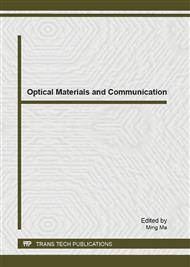[1]
M. Prabaharan, J. F. Mano: Macromol. Biosci. Vol. 6(2006), p.991.
Google Scholar
[2]
S. Wan, M. Jiang and G. Z. Zhang: Macromolecules. Vol. 40(2007), p.5552.
Google Scholar
[3]
J. L. Zhang, R. S . Srivastava and K. R. D. Misra: Langmuir. Vol. 23(2007), p.6342.
Google Scholar
[4]
G. Fundueanu, M. Constantin and P. Ascenzi: Biomaterials. Vol. 29(2008), p.2767.
Google Scholar
[5]
F. O. Onofre, Y. J. Wang: Int. J. Pharm. Vol. 385(2010), p.104.
Google Scholar
[6]
M. J. Santander-Ortega, T. Stauner, B. Loretz, J. L. Ortega-Vinuesa, D. Bastos-González, G. Wenz, U. F. Schaefer and C. M. Lehr: J. Control. Release. Vol. 141(2010), p.85.
DOI: 10.1016/j.jconrel.2009.08.012
Google Scholar
[7]
H. G. Breitinger: Biopolymers. Vol. 69(2003), p.301.
Google Scholar
[8]
U. Funke, M. G. Lindhauer: Starch. Vol. 53(2001), p.547.
Google Scholar
[9]
S. Richardson, L. Gorton: Anal. Chim. Acta. Vol. 497(2003), p.27.
Google Scholar
[10]
L. Kaur, N. Singh and J. Singh: Carbohydr. Polym. Vol. 55(2004), p.211.
Google Scholar
[11]
Z.F. Jia, H. Chen, X. Y. Zhu and D. Y. Yan, J. Am. Chem. Soc. Vol. 128(2006), p.8144.
Google Scholar
[12]
O. V. Khutoryanskaya, Z. A. Mayeva, G. A. Mun and V. V. Khutoryanskiy: Biomacromolecules. Vol. 9(2008), p.3353.
Google Scholar
[13]
Y. Ohya, M. Toyohara, M. Sasakawa, H. Arimura and T. Ouchi: Macromol. Biosci. Vol. 5(2005), p.273.
DOI: 10.1002/mabi.200400221
Google Scholar
[14]
C. Clasen, W. -M. Kulicke, Prog. Polym. Sci. Vol. 26(2001), P. 1839.
Google Scholar
[15]
R. Dicke, K. Rahn, V. Haack and Th. Heinze: Carbohydr. Polym. Vol. 45(2001), p.43.
Google Scholar
[16]
H. B. Mao, C. M. Li, Y. J. Zhang, D. E . Bergbreiter and P. S. Cremer: J. Am. Chem. Soc. Vol. 125(2003), p.2850.
Google Scholar
[17]
S. B. Lee, S. C . Song, J. I. Jin and Y. S. Sohn: J. Am. Chem. Soc. Vol. 122(2000), p.8315.
Google Scholar
[18]
F. Meng, Z. Zhong and J. Feijen: Biomacromolecules. Vol. 10(2009), p.197.
Google Scholar
[19]
X. C. Yin, H. D. H. Stöver: Macromolecules. Vol. 35(2002), p.10178.
Google Scholar


